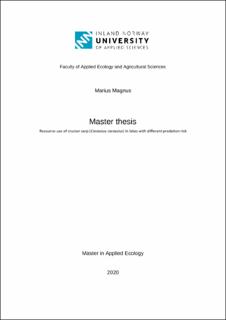| dc.description.abstract | Predator fish and prey its prey can have considerable effect on fish communities and can affect the behavior of its prey. stable isotope of carbon (d13C) and nitrogen (d15N can provide as a powerful and useful tool for estimating trophic position, littoral reliance and niche width for food webs in freshwater lakes. Twelve crucian carp lakes were sampled in southeast Norway. Three allopatric lakes with no predators, three lakes with Eurasian perch (Perca fluviatilis), three brown trout (Salmo trutta) and three with northern pike (Esox lucius) as top predators. With fish species richness varying from 1 – 7 fish species. I calculated the trophic position, littoral reliance and examined littoral vs pelagic use, and compared the niche width of crucian carp in the four different regimes. I expect, 1; that crucian carp will shift from pelagic resource use to littoral in lakes with predation, 2; that trophic position will be lower in lakes with predation and 3; the niche of crucian carp will be smaller in a more complex system. Results show that piscivore top predators influence littoral use and trophic position for crucian carp, and that the niche width changes in more complex systems. Thus, I conclude that piscivore top predators have an effect the structure and function of crucian carp communities. | en_US |
